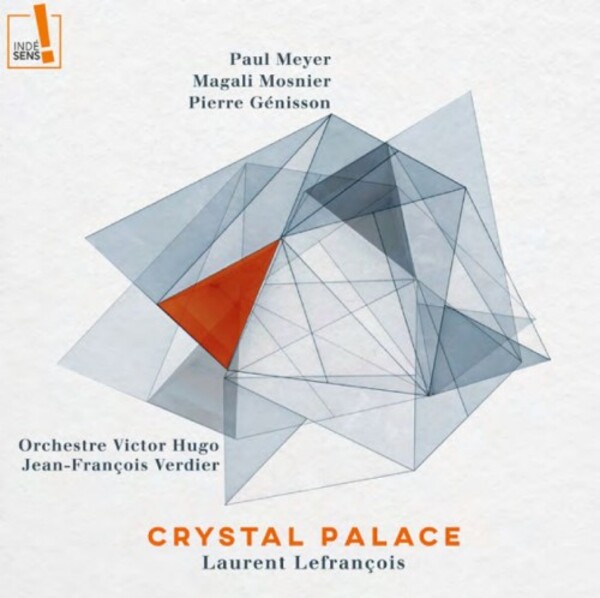Die Werke von Laurent Lefrançois scheinen sich vielfach mit den Bewegungen des Meeres zu beschäftigen. Sowohl vom Titel wie auch vom musikalischen Bild her bindet hier schon Le Nouveau Balnéaire daran an, das den Blicken von Monet und Proust auf die Normandie allgemein und Le Havre im Besonderen folgt. Auch der CD Titel bezieht sich auf dieses Umfeld, wenn er den Glasaufsatz, den Victor Hugo im Exil auf seinem Haus auf Guernsey bauen ließ und von dem er rundum aufs Meer sehen konnte, aufnimmt.
Die Werke bieten eine sensibel ausgeprägte Tonsprache, die mit Humor ebenso zu Recht kommt wie mit virtuoser Spielart. Neben Le nouveau Balnéaire sind dies hier drei Stücke für Solobläser, nämlich das kurze Siguirya für die Flöte und ein Konzert und ein Concertino für zwei Arten Klarinetten. Die kleine Klarinette in Es ist in einem höheren Tonumfang angesiedelt und klingt damit auch heller und durchdringender, als man es vom normalen Klarinettenklang üblicherweise gewohnt ist, sozusagen als Piccolo der Klarinetten.
Die Kompositionen bieten sowohl für das nicht allzu groß besetzte Orchester als auch für die Solisten sowohl technisch wie auch gestalterisch reizvolle Aufgaben, die in einem modern angehauchten Umfeld zum Tragen kommen. Das Orchester entwickelt in Le nouveau Balnéaire eine fein nuancierende Ensemblefarbe, bei der man sich die Küstenlandschaft der Normandie wie auch das unweigerlich damit verbundene Treiben in einem Hafen wie in Le Havre vorstellen mag. Darüber hinaus agiert das L’Orchestre Victor Hugo Franche-Comté als Begleiter der Solisten mit aufmerksamem und sorgfältig mitgehendem Zusammenspiel, das sie trägt.
Die Flötistin Magali Mosnier kann in Siguiyra mit sicherem Instinkt nicht nur ihr Instrument spielen, sondern in der Art der Deutung dazu beitragen, diesen vergessenen Rumba, dessen Spuren sich heute sonst nur noch im Flamenco finden lassen, mit einer subtil charmanten Interpretation neu beatmen.
Das Klarinettenkonzert hat drei Sätze zuzüglich eines als Kadenz gekennzeichneten. Damit stellt es sich auch vom Umfang her als vollwertiges Konzert dar. Paul Meyer gibt seinem Klarinettenton genau die flinken, sinnlichen und romantischen Impulse, die man schon seit Mozart mit dem Instrument verbindet. Vom aktiv betriebenen Beginn bis zum mystischen Ende bietet das Werk einen reichen für die Beteiligten, den diese intensiv nutzen und der auch für die Zuhörer abwechslungsreiches Hören ermöglicht.
Beim Concertino zeichnet Pierre Genisson mit seiner kleinen Klarinette die Vitalität des Instruments mit dem Wandern zwischen verschiedenen Ebenen, bei denen besonders die höheren Register, manchmal auch markant spitz, erklingen.
The works of Laurent Lefrançois often seem to deal with the movements of the sea. Both from the title and the musical image, Le Nouveau Balnéaire already ties in here, following the views of Monet and Proust on Normandy in general and Le Havre in particular. The CD title also refers to this environment when it takes up the glass top that Victor Hugo had built on his house in Guernsey during his exile and from which he could see all around to the sea.
The works offer a sensitively developed tonal language that is as comfortable with humor as it is with virtuoso playing. In addition to Le nouveau Balnéaire, there are three pieces here for solo winds, namely the short Siguirya for flute and a Concerto and Concertino for two types of clarinets. The small clarinet in E-flat is set in a higher range and thus also sounds brighter and more penetrating than one is usually accustomed to from the normal clarinet sound, as a piccolo of clarinets, so to speak.
The compositions offer for the not too large orchestra as well as for the soloists both technically and musically appealing tasks, which come to fruition in a modern-influenced setting. The orchestra develops a finely nuanced ensemble color in Le nouveau Balnéaire, in which one might imagine the coastal landscape of Normandy as well as the inevitably associated hustle and bustle of a port like Le Havre. In addition, L’Orchestre Victor Hugo Franche-Comté acts as accompanist to the soloists with attentive and carefully involving interplay that carries them along.
In Siguiyra, flutist Magali Mosnier is able not only to play her instrument with sure instinct, but in the way she interprets it, she helps to breathe new life into this forgotten rumba, traces of which can otherwise only be found in flamenco today. This is for sure a with a subtly charming interpretation.
The clarinet concerto has three movements plus one marked as a cadenza. Thus, it presents itself as a full concerto. Paul Meyer gives his clarinet tone precisely the nimble, sensual and romantic impulses that have been associated with the instrument since Mozart. From the actively driven beginning to the mystical end, the work offers a rich for the participants, which they use intensively and which also allows for varied listening for the listeners.
In the Concertino, Pierre Genisson’s small clarinet draws out the instrument’s vitality with its wandering between different levels, in which especially the higher registers, sometimes strikingly pointed, are heard.




















